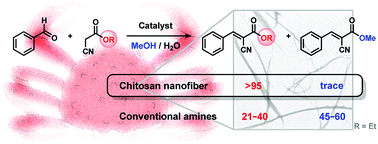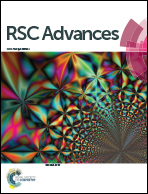Chitosan nanofiber-catalyzed highly selective Knoevenagel condensation in aqueous methanol†
Abstract
A chitosan nanofiber (CsNF)-catalyzed Knoevenagel reaction in green solvent, namely aqueous methanol, was investigated. CsNFs solely catalyzed the desired C–C bond formations in high yield with high selectivity, while conventional small-molecule amines, such as n-hexylamine and triethylamine, inevitably promoted transesterification to produce a large amount of solvolysis byproducts. Structural and chemical analyses of CsNFs suggested that the unique nanoarchitecture, in which chitosan molecules were bundled to ensure the high accessibility of substrates to catalytic sites, was critical to the highly efficient Knoevenagel condensation. The products were obtained in high purity without solvent-consuming purification, and the CsNF catalyst was easily removed and recycled. This study highlights a novel and promising function of CsNFs in green catalysis as emerging polysaccharide-based nanofibers.



 Please wait while we load your content...
Please wait while we load your content...